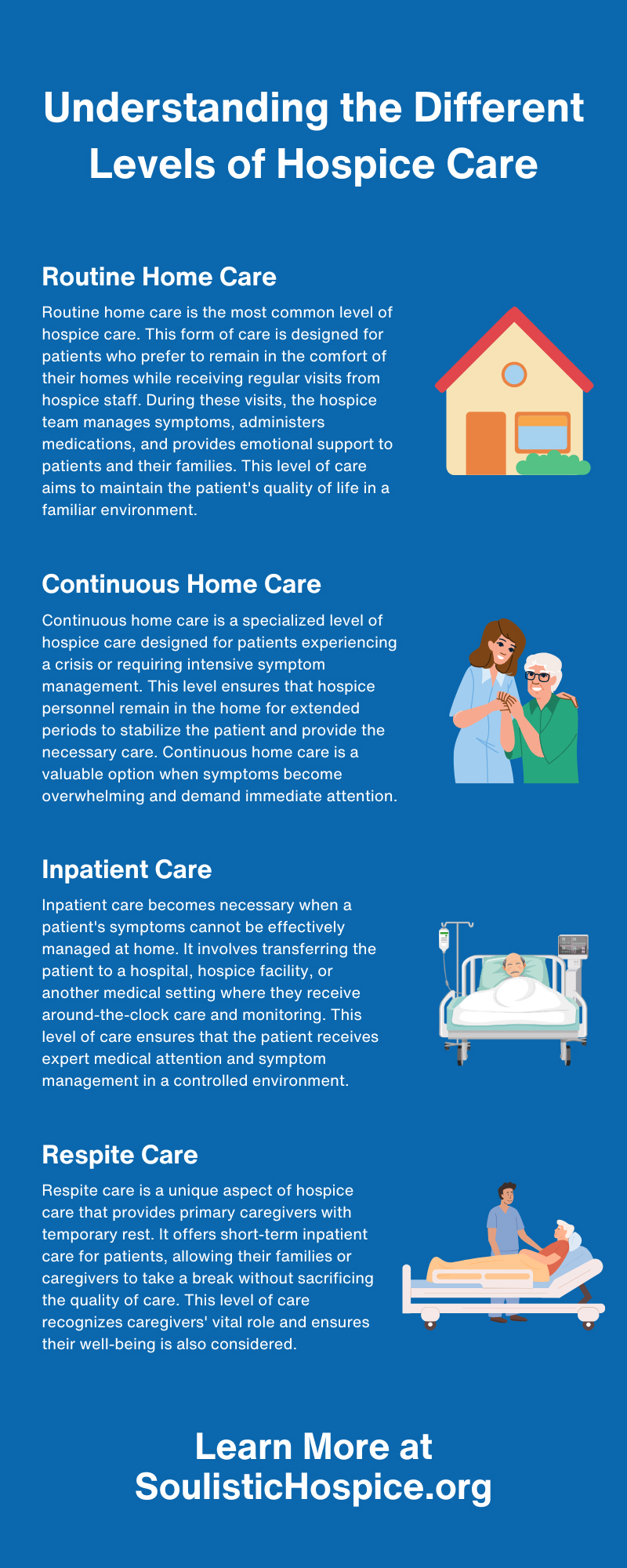
When it comes to hospice, learning about the various types of care can make a significant difference in ensuring your loved one receives the best possible support. Whether you're a senior looking into options for yourself or a caregiver seeking information for a family member, understanding the different levels of hospice care is essential. We’ll walk you through what hospice care entails and explore the distinct levels of care available, helping you make informed decisions during this pivotal time.
Exploring the Different Levels of Care
Hospice care is not a one-size-fits-all solution. Different levels of care are designed to meet specific needs, each with its own purpose and criteria. Let's explore these levels to understand how they cater to a patient's unique requirements.
Routine Home Care
Routine home care is the most common level of hospice care. This form of care is designed for patients who prefer to remain in the comfort of their homes while receiving regular visits from hospice staff. During these visits, the hospice team manages symptoms, administers medications, and provides emotional support to patients and their families. This level of care aims to maintain the patient's quality of life in a familiar environment.
The duration of routine home care varies based on individual needs, but it's generally ongoing. Patients who are stable and can manage their symptoms with regular visits are excellent candidates for this level of care. Routine home care an ideal option for those who wish to stay at home and have a dedicated support system from hospice professionals.
Routine home care also offers peace of mind to families by ensuring their loved ones receive consistent and professional care without the need for frequent hospitalizations. The hospice team focuses on creating a serene environment, allowing patients to cherish moments with their families while receiving the necessary medical attention.
Continuous Home Care
Continuous home care is a specialized level of hospice care designed for patients experiencing a crisis or requiring intensive symptom management. This level ensures that hospice personnel remain in the home for extended periods to stabilize the patient and provide the necessary care. Continuous home care is a valuable option when symptoms become overwhelming and demand immediate attention.
The purpose of continuous home care is to prevent unnecessary hospitalizations and provide comfort during difficult times. It allows patients to remain at home while receiving the high level of care they need. The hospice team works diligently to address symptoms, administer medications, and ensure the patient's well-being until stability is achieved.
Continuous home care is typically short-term, lasting a few days to a week. It provides essential support to patients and their families, reassuring them that expert assistance is readily available whenever needed. This level of care is particularly beneficial in managing complex symptoms and ensuring the patient remains as comfortable as possible during critical moments.
Inpatient Care
Inpatient care becomes necessary when a patient's symptoms cannot be effectively managed at home. It involves transferring the patient to a hospital, hospice facility, or another medical setting where they receive around-the-clock care and monitoring. This level of care ensures that the patient receives expert medical attention and symptom management in a controlled environment.
The purpose of inpatient care is to address acute symptoms and stabilize the patient before returning them to a lower level of care. It provides a safe space for intensive treatments and close monitoring by healthcare professionals. Inpatient care is usually temporary, lasting from a few days to a few weeks, depending on the patient's condition.
Patients who require frequent medical interventions or have complex symptoms may benefit from inpatient care. It offers peace of mind to families by ensuring their loved ones receive specialized medical attention tailored to their unique needs. Inpatient care serves as a bridge between higher levels of care and the comfort of home-based services.
Respite Care
Respite care is a unique aspect of hospice care that provides primary caregivers with temporary rest. It offers short-term inpatient care for patients, allowing their families or caregivers to take a break without sacrificing the quality of care. This level of care recognizes caregivers' vital role and ensures their well-being is also considered.
The purpose of respite care is to allow caregivers to recharge and attend to their own needs. It offers a safe and nurturing environment for patients, allowing caregivers to step away temporarily while knowing their loved ones are in capable hands. Respite care is typically available for a few days and can be scheduled as needed.
Caregivers often benefit immensely from respite care, as it allows them to return refreshed and ready to provide continued support. It acknowledges the challenges of caregiving and emphasizes the importance of self-care. Respite care is a valuable resource for maintaining the overall well-being of patients and their caregivers.
Choosing the Right Level of Care
Selecting the appropriate level of hospice care requires careful consideration of several factors. One of the most crucial aspects is open communication with healthcare providers. Engaging in honest discussions about the patient's condition, preferences, and goals can help determine the most suitable level of care.
Factors to consider include the patient's current health status, symptom management needs, and the level of support available at home. Involving the patient, their family, and healthcare professionals in decision-making process ensures that the chosen level of care aligns with the patient's wishes and provides the necessary support.
Choosing the right level of care empowers families to make informed decisions that prioritize the patient's comfort and quality of life. It allows patients to receive the care they need in a setting that best suits their needs and preferences. By considering individual circumstances and engaging with healthcare experts, families can ensure they are making choices that reflect their loved one's values and desires.
Receive Care Through Soulistic Hospice
Navigating the world of hospice care may seem daunting, but understanding the different levels of care can provide clarity and peace of mind. Each level serves a unique purpose and caters to specific needs, ensuring that patients receive the best possible care during this critical phase of life.
We encourage you to seek information and support from healthcare professionals and hospice services to make informed decisions. Remember, you're not alone on this journey—compassionate professionals are here to guide you every step of the way.
For personalized guidance and comprehensive hospice care services, contact Soulistic Hospice today. Our experienced team is dedicated to providing exceptional care and support to patients and their families.
By understanding the various levels of hospice care, you can make choices that reflect your loved one's wishes and ensure they receive the highest quality of care. Choose compassion, understanding, and hospice care that makes a meaningful difference.









